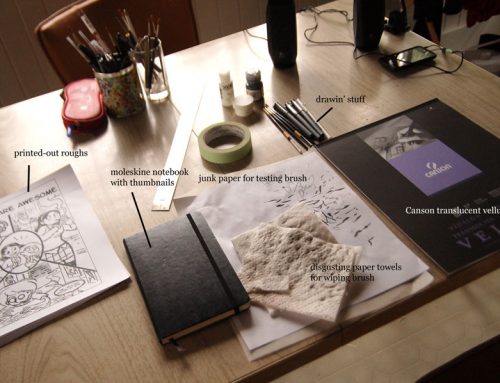test heading
[From the desk of Steven Seagle]
I’m always amazed by people who tell me that they could
never do what I do: tell a story. I think it’s the opposite. I think people
can’t not tell a story. I think it’s in our blood. Genetic? Jungian? I
don’t know, but I blame a little something I call:
B-M-E
Sure it’s core to writing a story, but it’s also innate to
human existence:
B-M-E
When it’s absent from a situation, or when the facts of its
presence are insufficient, we fill in the blanks and create:
B-M-E
Beginning-Middle-End
We can’t help ourselves.
Think about it. The whole of our human existence is measured
out as B-M-E:
You’re born. You work.
You die.
Maybe you imagined a different middle:
You’re born. You love.
You die.
Maybe my ending was your middle and you had a different ending
altogether:
You’re born. You die.
You’re born again in the form of a praying mantis.
Even people who tell me they could never write a story spend
most of their day (if not life) doing just that – conveying events in the form
of B-M-E. When someone asks you how your day was, you tend to start at the
beginning, work your way through the middle and wrap it up with how it ended.
Sure the details may differ, and that’s where doing something like writing professionally
develops (hopefully) a better sense of how to convey B-M-E, but each of us has within
a raconteur lurking somewhere.
Here, see if you can even begin to stop yourself from
creating a tale when you consider this worded image:
A car pulls away at
high speed from a person lying in the
middle of an intersection, a bag of groceries scattered around them
Writer or not, your mind has probably already started telling
you the story. And despite the fact that what was described with words was a
single instant, your mind has most likely started to fill in the missing parts
using an inborn sense of B-M-E. For most people the B-M-E associated probably
goes a little something like this:
B = Car hit person
M = Person was knocked
down and spilled their groceries
E = Car sped away from
the scene
It’s likely that’s what you came up with, but that is only one
possible read of the worded image. Most people would tend to fill in the blanks
with the person as the victim. But nothing in the image itself:
A car pulls away at
high speed from a person lying in the
middle of an intersection, a bag of groceries scattered around them
explicitly names the person in the intersection as the assault-ee.
What if we filled in the blanks incorrectly? What if the car wasn’t the
“villain” at all? What if the driver was the victim and the person on
the ground was the bad-guy (or bad-gal, because, of course, nothing in the
description mentions anything about gender either!)? I bet you’ve already
started reconstructing your B-M-E. Your mileage may differ, but here’s mine:
B=Person tried to
attack driver at intersection
M=Driver threw bag of
groceries out window at attacker’s head
E=Attacker was knocked
down by groceries as driver made her (or his…or their!) escape
We fill in the blanks based on past experience. We make assumptions
about what we see, hear, taste, smell, and touch. That’s not news. But what I
rarely hear mentioned about all this is that those assumptions tend to be
structured in the most basic story sense: B-M-E.
So what happens when we jump from written cues to visual? Gene
Yang has had such an incredible year with his 1:2 book American Born Chinese that he (hopefully!) won’t mind me pulling out three panels of his
great tome for a little field test. Here are three sequential wordless images
from the book. It’s a scene that’s only three panels long, but with no words, I’ll
bet you can still B-M-E the full story between the characters Jin and Amelia
(do that, then start reading again when you’re done!):


Okay, not bad. You used visual cues to determine they’re in
a movie theater and based on previous B-M-E experiences (from your life or
others) you pieced together what happened: Jin is considering his chances for
making a move, he goes for it and Amelia is shocked, but then she leans in
leaving Jin surprised that his courage paid off, or something like that, right?
Great! But… (you knew there’d be one, right?!) I have, in
fact, suckered you! The panels above weren’t actually in the right order. That
didn’t stop you from making sense of them, but can you suss out the real
B-M-E of this micro story when the three panels are placed in their proper sequence
(come back after you’ve cracked it!):
Good. Sure. Easy. Jin and Amelia are at the movies, leaning
in, feeling close, then Amelia suddenly sits bolt upright having thought of
something troubling, Jin doesn’t know what’s up. Finally, Amelia’s eyes glaze
over, something is wrong and Jin suspects he might know what that something is…him.
That works, right?
Great! But…what if I told you that the panels above weren’t
complete? This mini-story isn’t a three
panel sequence at all. It’s actually a four panel sequence. And here’s
how it really plays:


Okay, got it – same basic story as before, but with the
actual ending to the scene in place we now know the sticking point, right? A
jealous, hot-head rival for Amelia’s affections, who makes his position known
by coming to Jin’s house later and socking him in the face before leaving the
scene.
Or are we just back to the story of the car the pedestrian and
the groceries again?
I have to confess, Gene is likely to come to my house and
punch me in the cheeks over this whole blog. Because the fact is, nothing
above was the correct visual story laid out in American Born Chinese. I left
out panels in the movie theater, never gave the correct sequence, and that
punch image is from way later in the book. A complete disservice to Gene’s
incredible storytelling abilities…to illuminate your inherit story-making abilities
I took it all out of context and out of order and…you were
still able to B-M-E it. We can’t stop ourselves! We have to make order of what
we’re being given as written words or visual cues or…
Or when we’re reading comics…both.
That’s the really interesting thing about this jewel of an
art form. It’s working on two modalities at once, and you’re processing the
gaps (intentional and unintentional alike) to complete those scenes, stories,
and themes. But just like the intersection/groceries/car fragment above, don’t
be so sure you’ve given a comics page let alone an entire graphic novel it’s
only possible reading. Here’s the cold –hard truth:
We fill in the blanks.
And we fill them in with whatever we have.
And we might get them very right…or very, very wrong…
But either way, we make the work, not just the author’s, but ours.
So with that, here’s the first image from Genius, the First Second book I’m doing with my long-time, brilliant collaborator Teddy Kristiansen, due out next year. The image contains many clues about what the story is about. Feel free to B-M-E all you like until then. . .
[UP NEXT WEEK: CALISTA BRILL]

















Great post. It’s very refreshing. It’s gonna help me a lot in my Writing Graphic Novel class.
This was a great post – thanks Steven!